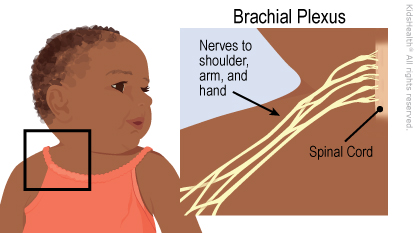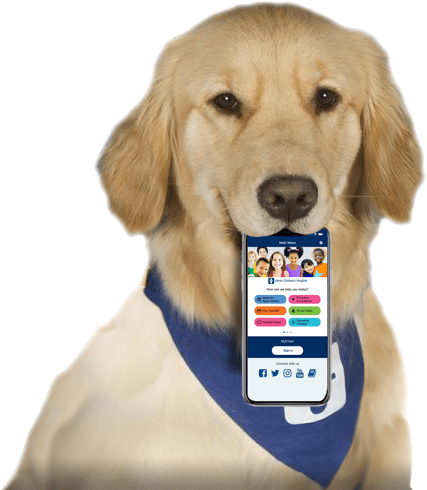Newborn Brachial Plexus Injuries
What Is a Brachial Plexus Injury?
Brachial plexus injuries affect the nerve network that provides feeling and muscle control in the shoulder, arm, forearm, hand, and fingers.
In newborns, these injuries can happen if:
- the birth is complicated by a breech (bottom-first) delivery
- the mother has a very long labor
- the baby weighs 8 pounds or more
- the baby's shoulders are too wide to fit through the birth canal
There are different kinds of brachial plexus (BRAY-kee-ul PLEK-sis) injuries. Depending on where the nerve damage is, the injuries sometimes are called neonatal brachial plexus palsy, brachial plexus birth palsy, or Erb's palsy.
What Happens in a Brachial Plexus Injury?
During childbirth, a brachial plexus injury can happen if the baby's neck is stretched to one side.
The brachial plexus nerve network begins with nerve roots at the spinal cord in the neck and reaches to the armpit. Nerves branch out from there and continue down the arm to the forearm, hand, and fingers.

When a strong force increases the angle between the neck and shoulders, the brachial plexus nerves might stretch or tear. The injury may also pull the nerve roots of the brachial plexus from the spinal cord. Damaged nerves carry sensation poorly and make muscle movements weak.
What Are the Signs & Symptoms of a Brachial Plexus Injury?
Signs of a brachial plexus injury usually include:
- full or partial lack of movement, especially in the shoulder and elbow
- a weakened grip
- numbness
- an odd position (the arm may bend toward the body or hang limp)
How Is a Brachial Plexus Injury Diagnosed?
Neonatal brachial plexus injuries are a common type of birth injury. Yet, identifying them in newborns can be hard. Doctors will check the affected arm for paralysis, numbness, position, and grip strength. They also will check a baby's Moro reflex (startle response). This is when a baby throws back their head, extends the arms and legs, and then pulls them back in
A specialist who treats infants with these injuries usually oversees the tests and treatments. The specialist might order:
- X-rays
- nerve conduction study (NCS) and electromyogram (EMG) to test nerve and muscle function
- magnetic resonance imaging (MRI)
How Is a Brachial Plexus Injury Treated?
Most babies with a brachial plexus injury regain both movement and feeling in the affected arm. In mild cases, this might happen without treatment.
Many babies will need physical therapy or occupational therapy. A physical therapist will show parents exercises to do at home to help their baby get better. Massage techniques and stretching also can help.
For a more severe injury, a child will be cared for by a team of specialists from:
- neurosurgery
- neurology
- orthopedic surgery
- physical medicine and rehabilitation (PM&R)
- occupational therapy
- physical therapy
If pain, weakness, or numbness continue, a neurosurgeon might do surgery to help. Options include:
- Nerve grafts: A nerve from another area of the body, such as a rib or the back of the foot, is used to patch an injured brachial nerve. A nerve framework from an organ donor or a manufactured nerve growth guide also can encourage nerve growth.
- Nerve transfer: A healthy nerve in the area or some of its fibers restores injured nerve connections.
- Muscle transfer: A muscle, usually taken from the child's thigh, replaces a paralyzed muscle in the arm.
- Tendon transfer: Tendons are moved from working muscles near the shoulder to increase arm movement and control.
What Else Should I Know?
After surgery, it may take 8 months or longer for new nerve function to show. Improvements in strength, range of motion, and control may continue for up to 18 months or more after surgery.
It's important to diagnose and treat a brachial plexus injury as quickly as possible. Early treatment offers the best chance for a baby's fullest recovery.
Reviewed by: Christopher A. Gegg, MD
Date Reviewed: Apr 10, 2022
















